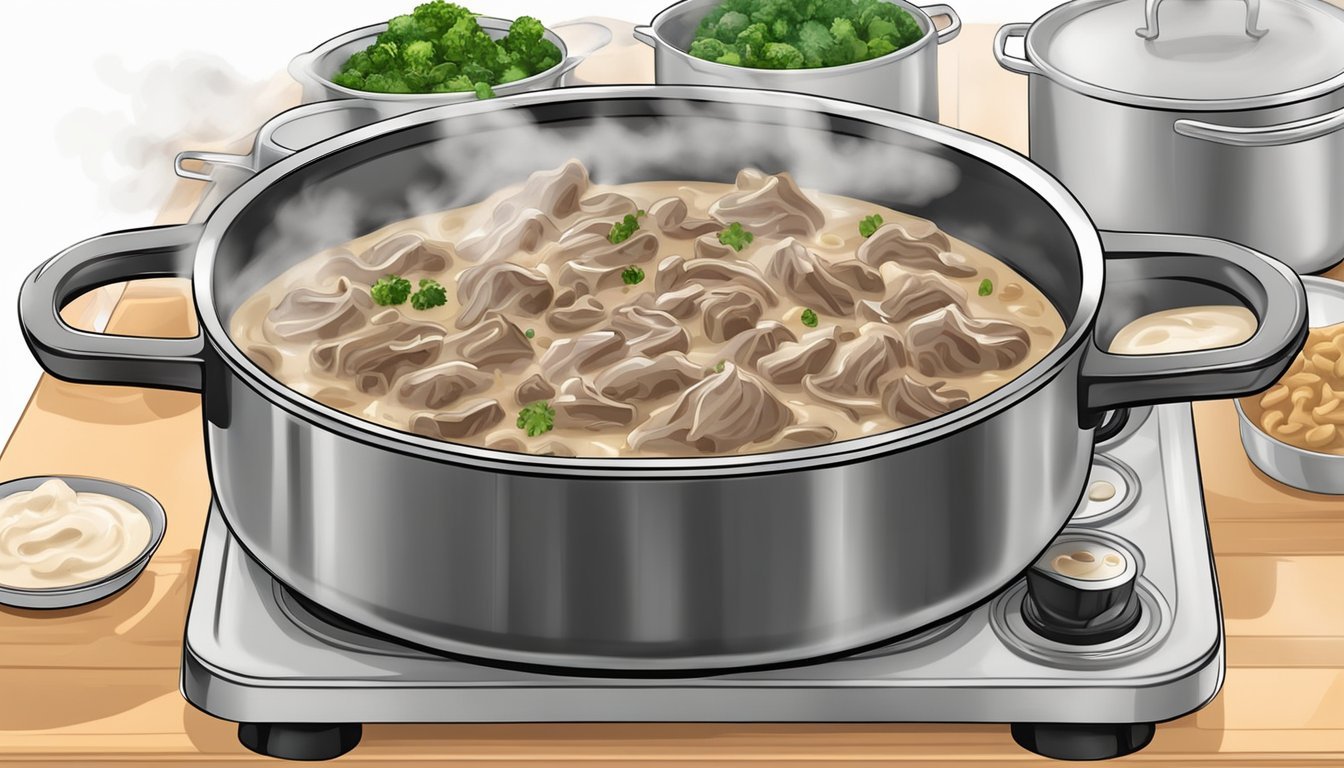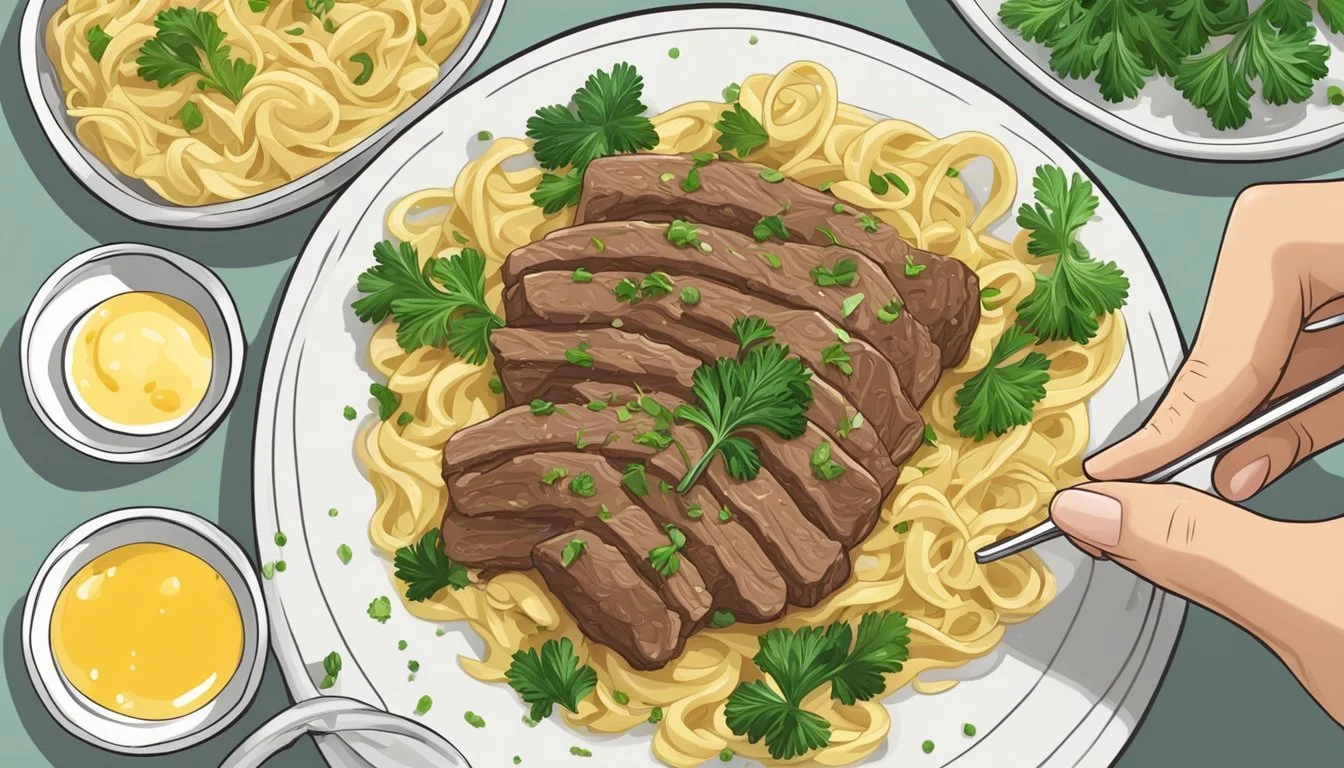Best Way to Reheat Beef Stroganoff
Maintaining a Creamy Sauce
Beef (What wine goes well with beef?) Stroganoff (What Wine Pairs Perfectly with Beef Stroganoff?), with its rich and creamy sauce, is a delicious meal that can bring comfort and satisfaction. Reheating this dish while maintaining the integrity of its creamy sauce is key to enjoying it as much as when it was freshly made. The best method to reheat beef stroganoff ensures that the flavors are preserved, and the sauce remains lusciously smooth.
A flavorsome beef stroganoff is the result of carefully balanced ingredients and the right reheating technique. Whether one chooses to reheat this delectable dish in a microwave or oven, the approach needs attention to detail. This includes managing the heat distribution and retaining the moisture which is crucial to avoid a dry or separated sauce.
Understanding the nuances of reheating beef stroganoff is essential for reviving its original texture and taste. Techniques such as stirring periodically and adding a touch of liquid can make all the difference. The goal is to breathe new life into the dish, ensuring each spoonful is as flavorful as if it's straight from the kitchen.
Understanding Beef Stroganoff
Beef Stroganoff is a classic dish known for its rich sauce and tender beef. It typically incorporates mushrooms and onions, served over egg noodles or rice.
Origins and Variations
Beef Stroganoff originates from 19th-century Russia and has since become a global favorite, with numerous variations reflecting local tastes and ingredient availability. The dish was traditionally made with sautéed pieces of beef served in a sauce with sour cream. Over time, it has adapted to include different meats such as chicken or pork and vegetarian options using mushrooms as the main component.
Key Ingredients and Preparation
The key ingredients in a traditional Beef Stroganoff include:
Beef: Usually tender cuts like sirloin or beef tenderloin (What wine goes well with beef tenderloin?).
Mushrooms: Provides a savory, earthy depth.
Onions: Adds a subtle sweetness and flavor base to the dish.
Sour Cream: The integral component for the characteristic creamy sauce.
Egg Noodles: Often the preferred base for serving, though rice or potatoes can also be used.
The preparation involves browning the beef, then cooking the mushrooms and onions before combining them with a broth and sour cream to create a rich, creamy sauce. The mixture is typically served over egg noodles. Careful attention is required to maintain the sauce's creaminess, particularly when reheating to avoid separation or curdling.
Storing Beef Stroganoff Properly
Proper storage of beef stroganoff is essential to maintain its quality and flavor, especially if one intends to reheat it while keeping the sauce creamy. Utilizing the right containers and temperature settings can maximize its shelf life and ensure the dish remains delicious for subsequent meals.
Airtight Containers and Refrigeration
For short-term storage, placing beef stroganoff in airtight containers is critical to prevent air exposure that can dry out the sauce. These containers should then be placed in the refrigerator within two hours of cooking to slow the growth of bacteria. It is advised to consume the refrigerated stroganoff within three to four days.
Freezing for Long-Term Storage
When freezing beef stroganoff, one should:
Allow the dish to cool to room temperature.
Transfer it to a freezer-safe airtight container or a heavy-duty freezer bag to prevent freezer burn and flavor transfer.
Clearly label the container with the date of freezing.
Store in the freezer where it can last for up to three months.
Note: For optimal texture, one should stir the stroganoff before serving after reheating, as separation may occur during freezing and thawing.
Reheating Fundamentals
When reheating beef stroganoff, the primary goals are to ensure the dish is safe to eat, while preserving its creamy texture, rich flavor, and tender beef. Achieving these aims involves careful temperature management and reheating techniques.
Food Safety Considerations
Food Safety is critical when reheating any dish. One should reheat beef stroganoff to an Internal Temperature of 165°F as recommended by food safety experts to eliminate harmful bacteria. This temperature is best checked using a food thermometer, ensuring the stroganoff is safe to consume.
Before reheating:
Remove stroganoff from the refrigerator and let it sit at room temperature for about 15 minutes.
Reheating process:
Heat until the internal temperature reaches 165°F.
Do not leave leftovers at room temperature for more than 2 hours.
Maintaining Creaminess and Flavor
To maintain the Creaminess and Flavor of the sauce:
Add moisture:
Stir in a small amount of Cream or broth to add moisture and enhance the sauce's creamy texture.
Heat evenly to prevent cold spots, which can affect both flavor and food safety.
Avoiding Overcooking and Separation
Overcooking can lead to a grainy sauce and tough beef, while Separation of the sauce detracts from the creamy texture. Here's how to avoid these issues:
Oven Reheating:
Cover with aluminum foil to trap Moisture.
Stir occasionally to prevent Overcooking.
Microwave Reheating:
Reheat in small intervals to prevent Overcooking.
Stir between intervals to maintain even temperature and sauce consistency.
Reheating Techniques
Proper reheating of beef stroganoff preserves its creamy sauce and ensures even heating. Whether using a microwave, oven, or stovetop, selecting the right method can resurrect the flavors of this classic dish.
Microwave Method for Quick Reheating
For rapid reheating, the microwave is efficient. To retain moisture:
Place the stroganoff in a microwave-safe dish.
Add a little liquid, like beef broth, to the dish.
Cover it with a lid or microwave-safe plastic.
Heat on high for 1-2 minutes.
Stir occasionally to promote even heating.
Oven Method for Even Heating
The oven method ensures a more uniform distribution of heat. Follow these steps:
Preheat your oven to 350°F (180°C).
Transfer the stroganoff into an oven-safe dish and mix in a few tablespoons of liquid for moisture.
Cover the dish with aluminum foil.
Bake for 10-20 minutes, stirring halfway through the heating period.
Ensure the dish reaches an internal temperature of 165°F.
Stovetop Method for Controlled Heating
For more control over the reheating process, the stovetop is ideal. Here's how:
Place the stroganoff in a skillet or saucepan.
Add a splash of liquid (water, cream, or broth) to prevent the sauce from thickening.
Cover with a lid to distribute heat evenly.
Warm the dish on low to medium heat.
It's crucial to stir frequently to avoid burning the sauce.
Final Touches and Serving
After reheating beef stroganoff, it's essential to serve it promptly, ensuring the sauce retains its creamy consistency. The right garnishes and accompaniments can elevate the dish to a satisfying meal.
Adding Garnishes to Enhance Flavor
Garnishes not only add a visual appeal but also introduce complementary flavors and textures to the dish. Here's how one can enhance their beef stroganoff:
Fresh herbs: A sprinkle of chopped parsley or dill (how long does dill last?) adds a burst of freshness.
Sour cream: A dollop on top before serving can enrich the sauce's creamy texture.
Black pepper: Freshly ground black pepper brings a subtle heat that complements the rich sauce.
Serving Suggestions with Salad and Vegetables
Pairing beef stroganoff with the right side can turn it into a well-rounded meal. Consider the following options:
Salad:
Simple greens: A salad of mixed greens dressed with vinaigrette can provide a light balance.
Cucumber salad: Its crispness contrasts well with the stroganoff's creaminess.
Vegetables:
Roasted vegetables: Carrots, parsnips, or Brussels sprouts roasted until tender-crisp offer a savory complement.
Steamed broccoli: Its vibrant color and subtle bitterness add balance to the richness of the stroganoff.
Planning Ahead to Save Time
For a busy individual, understanding the techniques of thawing and the benefits of meal prepping can significantly save time while ensuring beef stroganoff retains its creamy sauce upon reheating.
Thawing Techniques
Thawing beef stroganoff properly is crucial for preserving quality. A safe method is transferring the stroganoff from the freezer to the refrigerator at least several hours before reheating, or preferably, overnight. This slow-thaw process allows for even and gentle defrosting, maintaining the integrity of the cream sauce.
Benefiting from Meal Prepping
Meal prepping can streamline the reheating process. One can portion the stroganoff into individual servings before freezing. These single portions will thaw more quickly and can be reheated in less time, making it more convenient for those with time constraints. Organizing the stroganoff servings in microwave-safe containers also reduces the need for transferring dishes, thus saving additional time and effort.




